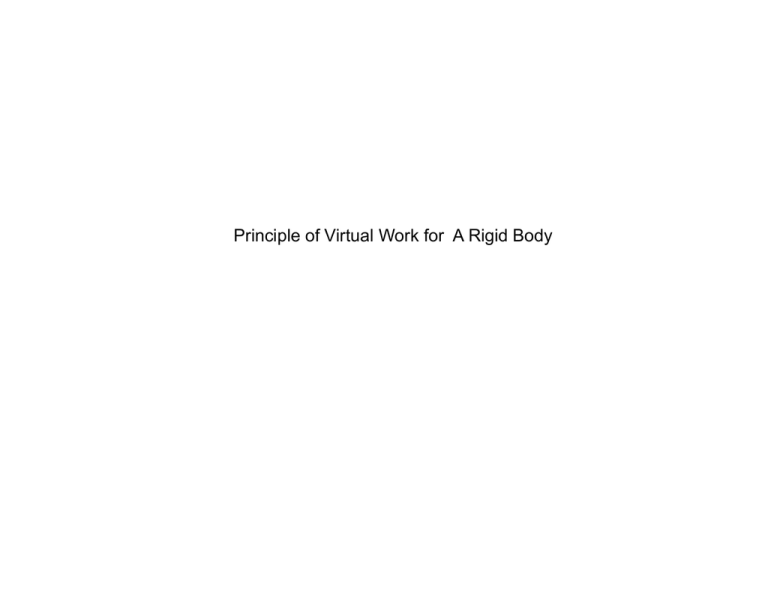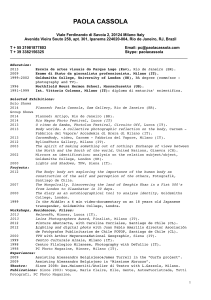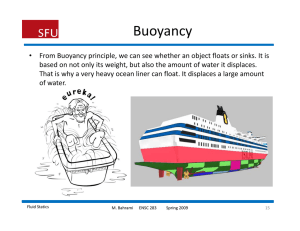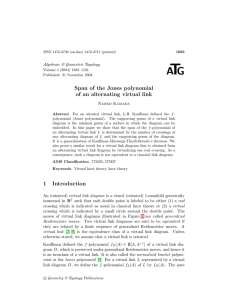Principle of Virtual Work for A Rigid Body
advertisement

Principle of Virtual Work for A Rigid Body rigid body displacements (in 2-D) θ D y x a general displacement of any point in a rigid body consists of a translation plus a rotation. If the translation and rotation are both small then the displacement at any point in a rigid body can be written as dr = dD + dθ k × r small small translation rotation translation: dr =dD = constant for all points in the body dD dD dD rotation: dr has a magnitude of rdθ dr dθ direction of dr is perpendicular to r y r dθ dr =dθk x r where k is a unit vector along the z-axis x if we have a series of forces, Fi , and couples , Ci ,acting on a rigid body then the virtual work, δW, done by these forces and couples if we give a smallll virtual i t l rigid i id b body d di displacement l t tto th the b body d iis F2 F1 C1 N M i =1 j =1 N M i =1 j =1 δ W = ∑ Fi ⋅ δ ri + ∑ C jδθ = ∑ Fi ⋅ δ ri + ∑ C j ⋅ δθ k where δ ri = δ D + δθ k × ri is the virtual displacement of each point where the forces act Thus M ⎛ N ⎞ N δ W = δ D ⋅ ⎜ ∑ Fi ⎟ + ∑ Fi ⋅ (δθ k × ri ) + ∑ C j ⋅ δθ k j =1 ⎝ i =1 ⎠ i =1 but Fi ⋅ (δθ k × ri ) = δθ k ⋅ ( ri × Fi ) since a ⋅ (b × c) = b ⋅ (c × a) = c ⋅ (a × b ) so the virtual work done is M ⎛ N ⎞ ⎛ N ⎞ δ W = δ D ⋅ ⎜ ∑ Fi ⎟ + δθ k ⋅ ⎜ ∑ ri × Fi + ∑ C j ⎟ j =1 ⎝ i =1 ⎠ ⎝ i =1 ⎠ M ⎛ N ⎞ ⎛ N ⎞ δ W = δ D ⋅ ⎜ ∑ Fi ⎟ + δθ k ⋅ ⎜ ∑ ri × Fi + ∑ C j ⎟ j =1 ⎝ i =1 ⎠ ⎝ i =1 ⎠ If equilibrium of the rigid body is satisfied then we have N ∑F = 0 i i =1 N M ∑r × F + ∑C i =1 i i j =1 j =0 and, hence δW =0 Thus, if a rigid body is in equilibrium the virtual work done by all the forces and moments acting on the body is zero, or in other words equilibrium δW =0 M ⎛ N ⎞ ⎛ N ⎞ δ W = δ D ⋅ ⎜ ∑ Fi ⎟ + δθ k ⋅ ⎜ ∑ ri × Fi + ∑ C j ⎟ j =1 ⎝ i =1 ⎠ ⎝ i =1 ⎠ However, we can also turn this relationship around say that If the virtual work done by all the forces and couples on a body is zero, for all possible virtual rigid body displacements, then the body must be in equilibrium, i.e. δW =0 equilibrium Principle of Virtual Work for a Rigid Body To prove the principle of virtual work: If we let δDx =δD and all other components of the translation =0 and set the rotation δθ =0 , then for zero virtual work we must have ⎛ N ⎞ δ D ⎜ ∑ Fix ⎟ = 0 ⎝ i =1 ⎠ so that we also find N ∑F ix i =1 =0 in a similar fashion we can show that N ∑F i =1 iy N ∑F i =1 i iz =0 =0 If, instead we give the body a pure virtual rotation, we find M ⎡N ⎤ ⎢ ∑ ri × Fi ⎥ + ∑ C jz = 0 ⎣ i =1 ⎦ z j =1 which is just the moment equilibrium equation for 2-D problems: ∑ M z = 0 Example: find the equilibrium angle for a platform of weight 200lb supported by two identical weightless links. All connections are smooth pins. i 5 ft 50 lb θ P 3 ft 3 ft 200 lb T1 equilibrium approach: ∑MP = 0 θ 50 − (T1 sin θ )( 3) + (T2 sin θ )( 3) = 0 T1 =T2 =T ∑F x ∑F y =0 2T sin θ − 200 = 0 θ 200 =0 2T cos θ − 50 = 0 T2 tanθ =4 θ = 76o T1 virtual work approach: δθ 5 θ T2 δθ δθ 50 200 δu=5δθ δu=5δθ θ θ 50 200 δ W = 50 δ u sin θ − 200 δ u cosθ = 0 tan θ = 4 note: tensions do no work in this assumed virtual rotation we can find the tensions if we want to by looking at additional virtual translations or rotations: T1 δu θ 3 δθ 50 δu=3δθ δθ 3 T2 θ 200 δ W = − (T1 sin θ ) δ u + (T2 sin θ ) δ u = 0 T1 = T2 = T T2 T1 50 δu same result as our previous moment equation δu θ δu θ 200 δ W = 50δ u − T1 cosθδ u − T2 cosθ = 0 T1 cos θ + T2 cos θ = 50 same result as first previous force equation p q T1 δu 50 δu δu θ T2 θ 200 δ W = (T1 sin θ ) δ u + (T2 sin θ ) δ u − 200δ u = 0 T1 sin θ + T2 sin θ = 200 same result as second previous force equation


